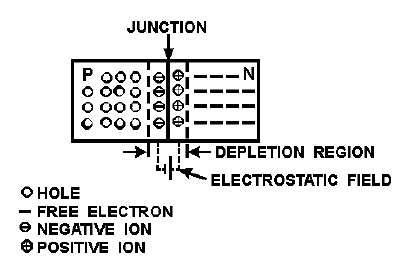1-20
charged ions. The diffusion of electrons and holes across the junction will continue until the magnitude of
the electrostatic field is increased to the point where the electrons and holes no longer have enough
energy to overcome it, and are repelled by the negative and positive ions respectively. At this point
equilibrium is established and, for all practical purposes, the movement of carriers across the junction
ceases. For this reason, the electrostatic field created by the positive and negative ions in the depletion
region is called a barrier.
Figure 1-17.—The PN junction barrier formation.
The action just described occurs almost instantly when the junction is formed. Only the carriers in
the immediate vicinity of the junction are affected. The carriers throughout the remainder of the N and P
material are relatively undisturbed and remain in a balanced condition.
FORWARD BIAS.—An external voltage applied to a PN junction is call BIAS. If, for example, a
battery is used to supply bias to a PN junction and is connected so that its voltage opposes the junction
field, it will reduce the junction barrier and, therefore, aid current flow through the junction. This type of
bias is known as forward bias, and it causes the junction to offer only minimum resistance to the flow of
current.
Forward bias is illustrated in figure 1-18. Notice the positive terminal of the bias battery is connected
to the P-type material and the negative terminal of the battery is connected to the N-type material. The
positive potential repels holes toward the junction where they neutralize some of the negative ions. At the
same time the negative potential repels electrons toward the junction where they neutralize some of the
positive ions. Since ions on both sides of the barrier are being neutralized, the width of the barrier
decreases. Thus, the effect of the battery voltage in the forward-bias direction is to reduce the barrier
potential across the junction and to allow majority carriers to cross the junction. Current flow in the
forward-biased PN junction is relatively simple. An electron leaves the negative terminal of the battery
and moves to the terminal of the N-type material. It enters the N material, where it is the majority carrier
and moves to the edge of the junction barrier. Because of forward bias, the barrier offers less opposition
to the electron and it will pass through the depletion region into the P-type material. The electron loses
energy in overcoming the opposition of the junction barrier, and upon entering the P material, combines
with a hole. The hole was produced when an electron was extracted from the P material by the positive
potential of the battery. The created hole moves through the P material toward the junction where it
combines with an electron.


